There was no rain for weeks and the tinder on the forest floor on the East End of Long Island was prepared to ignite – all it needed was a spark.
When it finally did on a gusty August afternoon, the flames caused trees to explode into a dark smoke – creating a sticky tar that clung on to responders for days.
The Sunrise Fire of 1995 turned day into night for those battling the flames – and it didn’t seem real to those who witnessed it.
“We had never seen anything to that magnitude before,” says John Jordan, commissioner of Suffolk County Fire, Rescue and Emergency Services.
At the time, Jordan was (and still is) a volunteer firefighter out of North Babylon, and the call to duty was spreading to firehouses further and further west almost as fast as the wildfire itself.
“I think at the time it was the largest mutual aid fire in the state’s history,” he says.
The East End is marking 25 years since the Pine Barrens were spun into an inferno by what is widely believed to be an impetus as small as a carelessly discarded cigarette or match.
“Battleground” tells the story of a forest that had seen fires burning for centuries – but never with so much at stake.
Battleground: The Sunrise Fire of 1995
The Pine Barrens – The War of the Woods
The Pine Barrens sits atop the greatest quantities of the purest drinking water on Long Island. It’s 106,000 acres of land is home to the most diverse species of plant and animal life anywhere in New York – some of which are endangered or threatened.
The condition of that drinking water is dependent upon its freedom from development. It took a lawsuit by the Pine Barrens Society in 1989 to keep developers, itching to build shopping malls and homes in the area, away from the land.
“This is a treasure and it would have been horrible to have lost it to another subdivision,” says Richard Amper, the society’s executive director. “If it was up to them, they would have paved over the entire Island.”
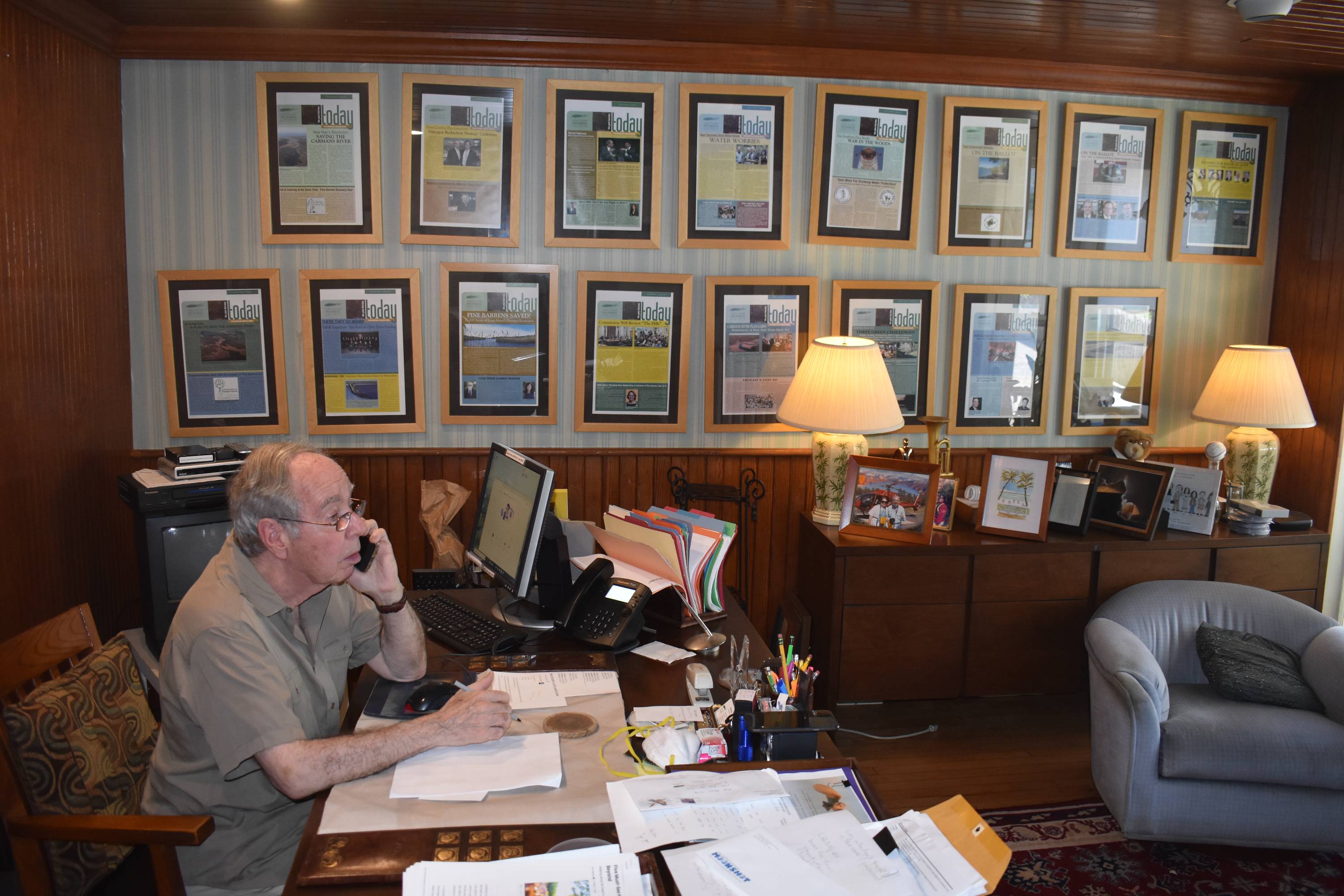
Richard Amper has been advocating for the Pine Barrens for decades. (Photo: Bob Doda)
The Pine Barrens Preservation Initiative lawsuit, the largest environmental legal action in state history, held those who wanted to develop the land accountable to the environment.
Years of litigation culminated with the passage of the Pine Barrens Protection Act of 1993 – an effort between politicians, environmental activists and even the developers. It was signed in the woods by Gov. Mario Cuomo.
News 12 Vintage: The signing of the 1993 Pine Barrens Protection Act
“The war of the woods is over, and the people of Long Island won,” Amper declared at the signing ceremony.
“If we had waited any longer it would probably have been lost in development,” he says. “There were hundreds of projects proposed that would have wiped out most of the Pine Barrens had we not had a plan.”
The law made the Long Island Pine Barrens the state’s third forest preserve (alongside the Catskills and the Adirondacks) and protected “a 53,000 acre Core Preservation Area where no new development is permitted and a 47,000 acre Compatible Growth Area where limited, environmentally compatible development is allowed,” according to the Pine Barrens Society.
It also created the Central Pine Barrens Commission – a five-member body that is made up of the regional director of the state Department of Environmental Conservation, the elected Suffolk County executive and the town supervisors or Brookhaven, Riverhead and Southampton.
“They oversee land use and land management in the central Pine Barrens,” says CPBC Executive Director John Pavacic. “We are all trying to manage the forest in a way that sustains the forest and helps to minimize the advent of wildfires.”
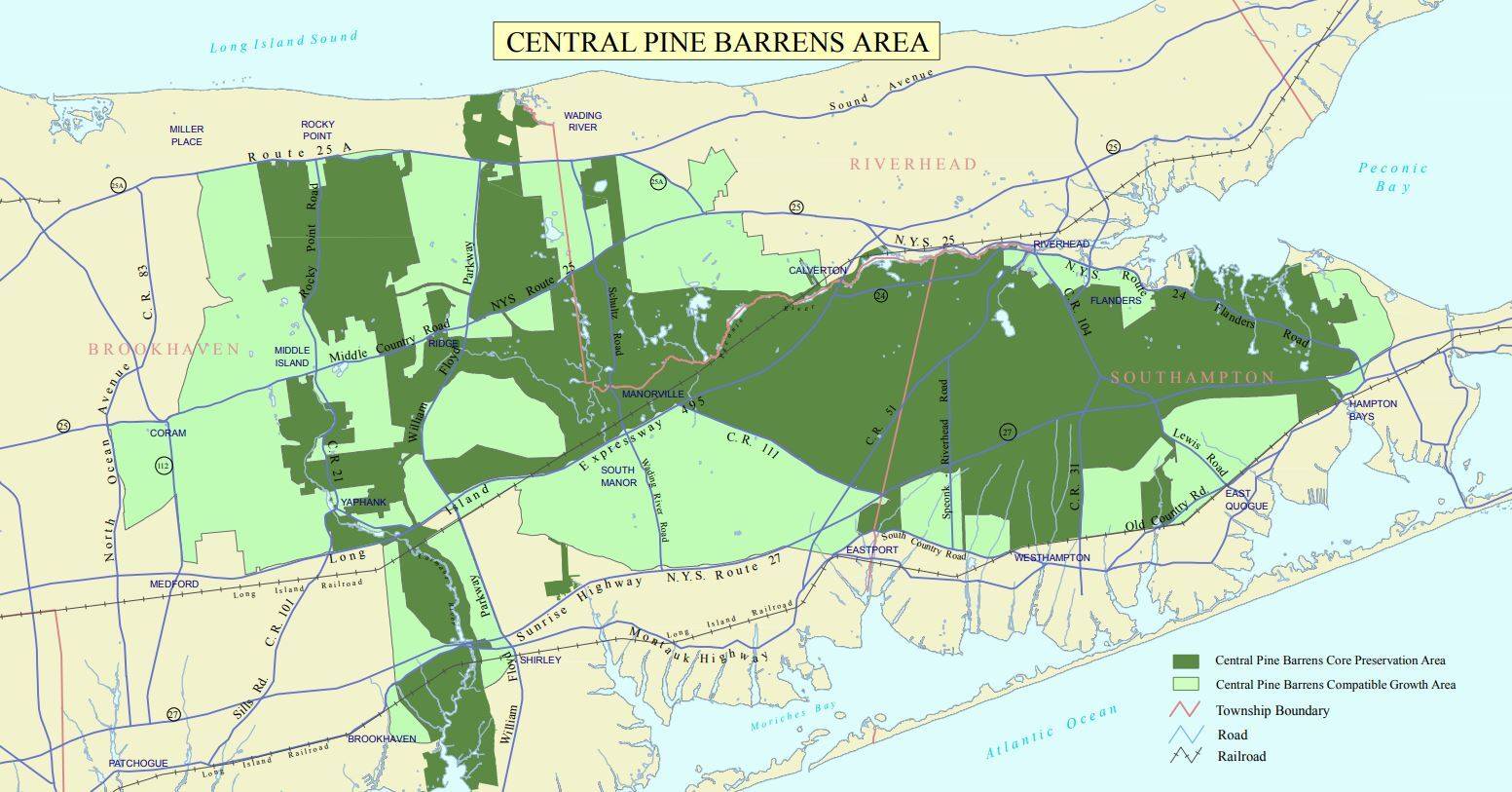
(Courtesy of the Central Pine Barrens Commission)
Necessary Destruction
The Pine Barrens is a fire-dependent ecosystem that has burned and rejuvenated for thousands of years in a destructive loop. The process is simple. A wildfire caused by a lightning strike would burn the pitch pine trees in the forest, which allows the pine cones to open and reseed the area.
“The pitch pines and the scrub oak – these species thrive on wildfire,” says Pavacic. “Pitch pines have two different types of pine cones. They only open after a fire has gone through. The fire melts the waxy coating that allows the cones to open up and they deposit their seeds. It’s an ecological adaptation that has evolved over thousands of years.”
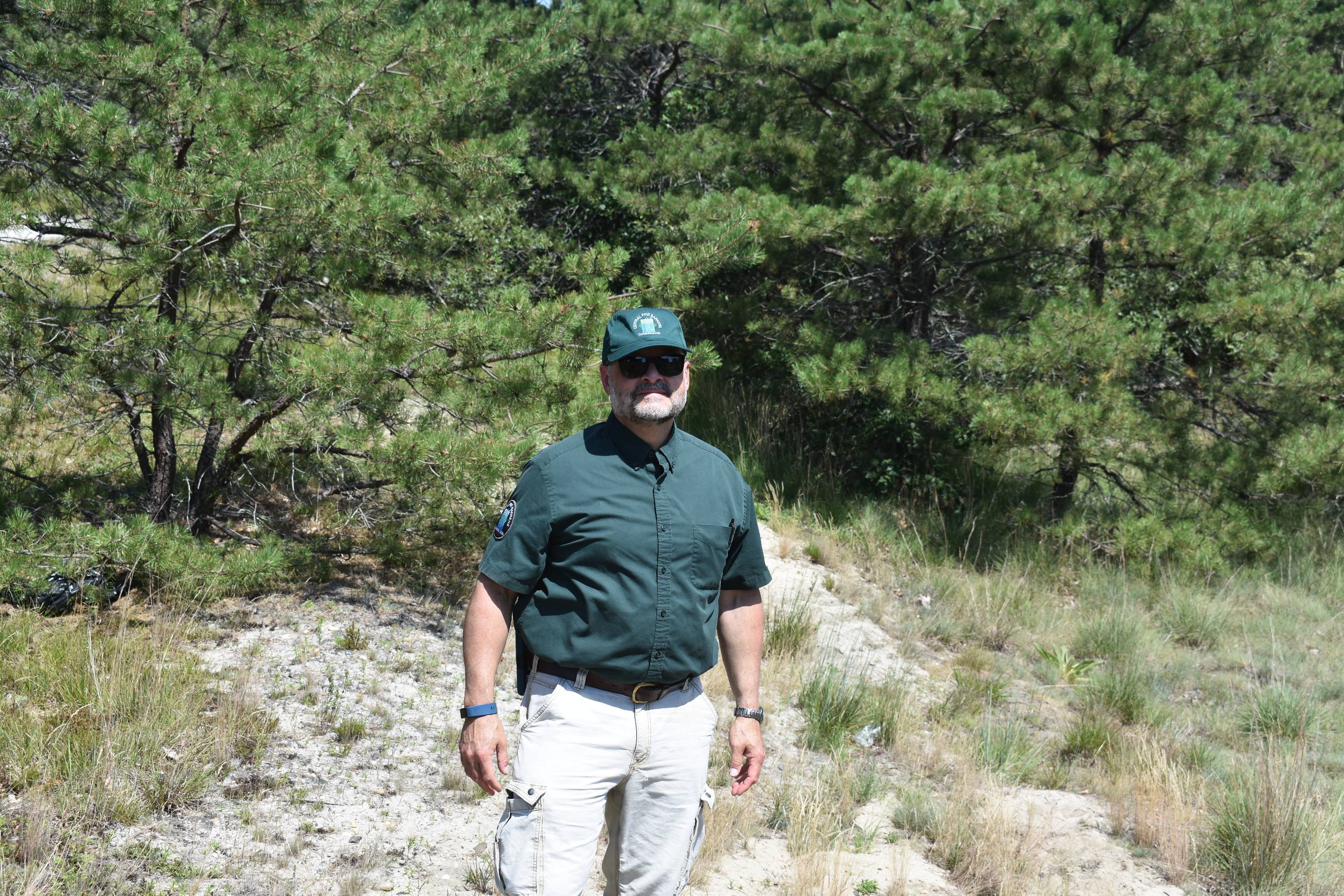
John Pavacic has served as executive director of the Central Pine Barrens Commission since 2010 (Photo: Bob Doda)
Other benefits of wildfires include the release of nutrients from dried-up vegetation back into the soil and the control of non-fire dependent invasive species that can cripple a forest.
When the wildfires of August 1995 arrived, letting them burn out was not an option. This time, there were homes and businesses in its path.
PHOTOS: Sunrise Fire of 1995 (Courtesy of The Express News Group)
The fire on the Sunrise Highway, fueled by windy conditions, burned for days - leaving thousands of acres of the preserved forest charred.
Tinderbox
Wildfires thrive on several key elements: Dry conditions, winds that can help accelerate the flames and low humidity.
On August 24, 1995 it hadn’t rained for about 21 days. North-northwest winds were sustained at 25 mph with gusts up to 35 mph and the humidity was at 17%.
“Those conditions just created the potential for a conflagration in areas of the Pine Barrens that hadn’t burned in a long time,” says Edward Schneyer, Suffolk’s director of emergency preparedness.
That afternoon, flames were first reported in the woods near Suffolk County Community College near Speonk-Riverhead Road – not far from Sunrise Highway.
Schneyer has been a volunteer firefighter in Eastport for the past 38 years. On the first day of the Sunrise Fire, he was a shift supervisor at the fire communications center.
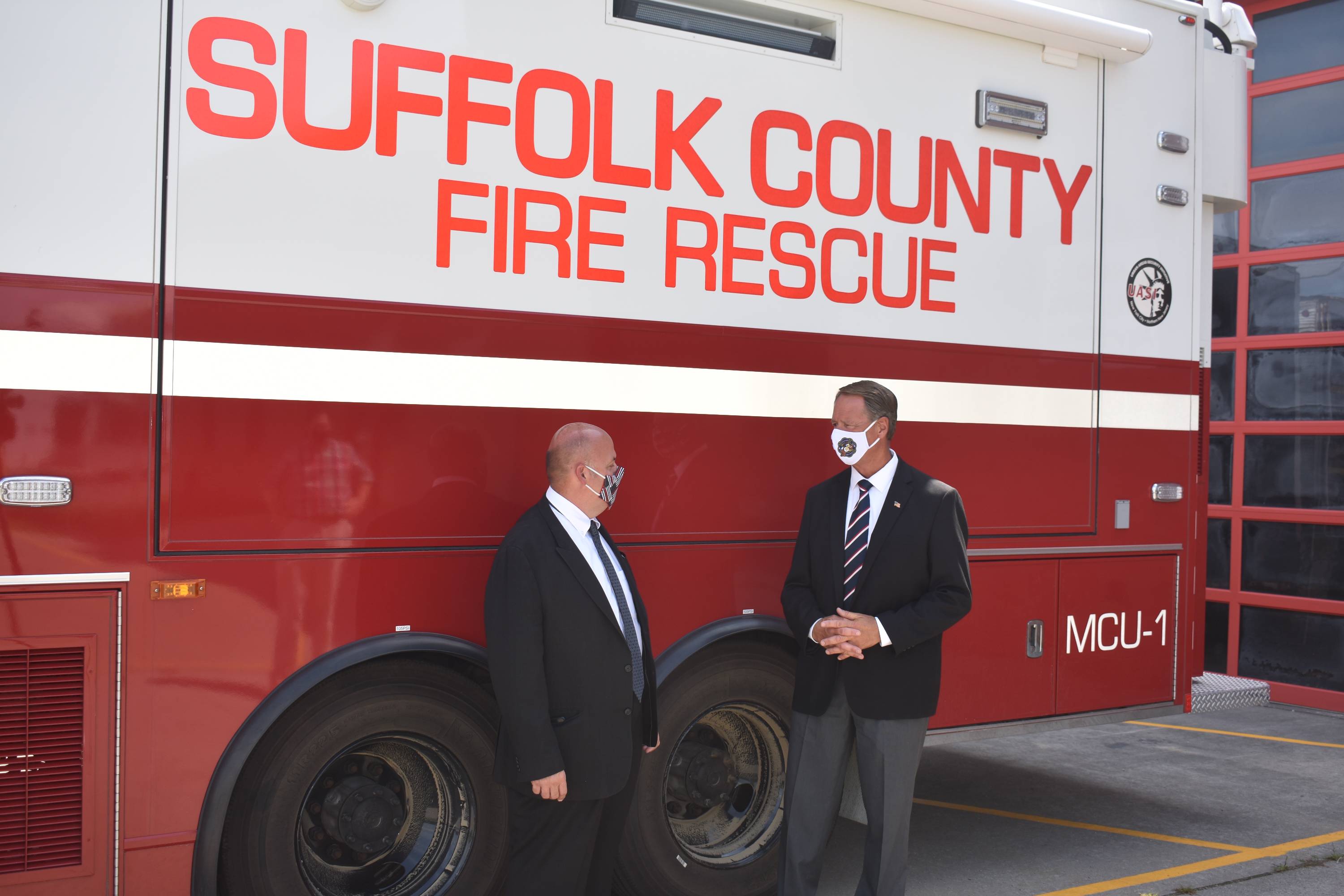
John Jordan Sr. (left) and Edward Schneyer (right) outside Suffolk County Fire, Rescue and Emergency Services in Yaphank (Photo: Bob Doda)
“The fire got reported and we thought it was going to be another mutual-aid fire until the first fire chief got on the scene,” he says. “His request to the fire communications center was ‘Get me everything you got’ – which is not a typical request.”
“We are talking about a fire department that was well-versed in fighting brush fires…we knew it was going to be a long day,” says Schneyer.
It wasn’t contained for three more days. Throughout the term of the wildfire - more than 3,000 fire, EMS, law enforcement and support personnel responded to the event, including 109 fire departments in Suffolk and 71 in Nassau.
The FDNY amassed 10 engines and New Jersey and Connecticut also came to assist. On the first night of the fire, President Bill Clinton pledged aid in the form of U.S. Forest Service members.
News 12 Vintage: President Clinton's statement on Sunrise Fire
Early into the incident, there were attempts to stop the voracious blaze on Speonk-Riverhead Road – but they were pushed back to Sunrise Highway where pieces of fire equipment seemed to materialize in the median of the 400-foot span. This is where responders hoped the blaze would end, barely two-hours into the incident.
“There was no blue sky over your head. You were in smoke. You were in heat. You were in soot.”
But the embers in the air were being carried too quickly and haphazardly across the roadway – igniting the canopies of trees and spreading fear that it could burn all the way to the waters on the South Shore.
News 12 Vintage: Walt Kane reports from the bridge on Speonk-Riverhead Road
“If I had not seen it firsthand, I would not have believed it,” says Danielle Campbell – a former radio reporter who had recently joined News 12 Long Island. She is the long-time environmental reporter for the station.
She stumbled across the fire while heading westbound on Sunrise Highway after a trip out to Montauk. With her children in the car, Campbell had no choice but to get off the road. She found a deli in a safe area, allowed her children to get some snacks and called News 12. She then went live on-air to explain what she saw.
When News 12 trucks began to arrive, she took her children home and returned to the scene. It was then that the flames passed over her head onto the other side of Sunrise Highway.

Danielle Campbell watched as the flames on Sunrise Highway jumped over the 400-foot span. (Photo: Bob Doda)
“It was really frightening and amazing at the same time,” says Campbell. “The fire was in the canopies of these pitch pines – if you’ve ever seen a Christmas tree go on fire, that’s what we were experiencing. It was almost like an explosion.”
Efforts to stop the fire on the highway failed, though successful defensive stands for the volunteer brigade were to come – notably at the Hamptons West Estates. But the blaze had become out of control and an army of volunteers were answering the call.
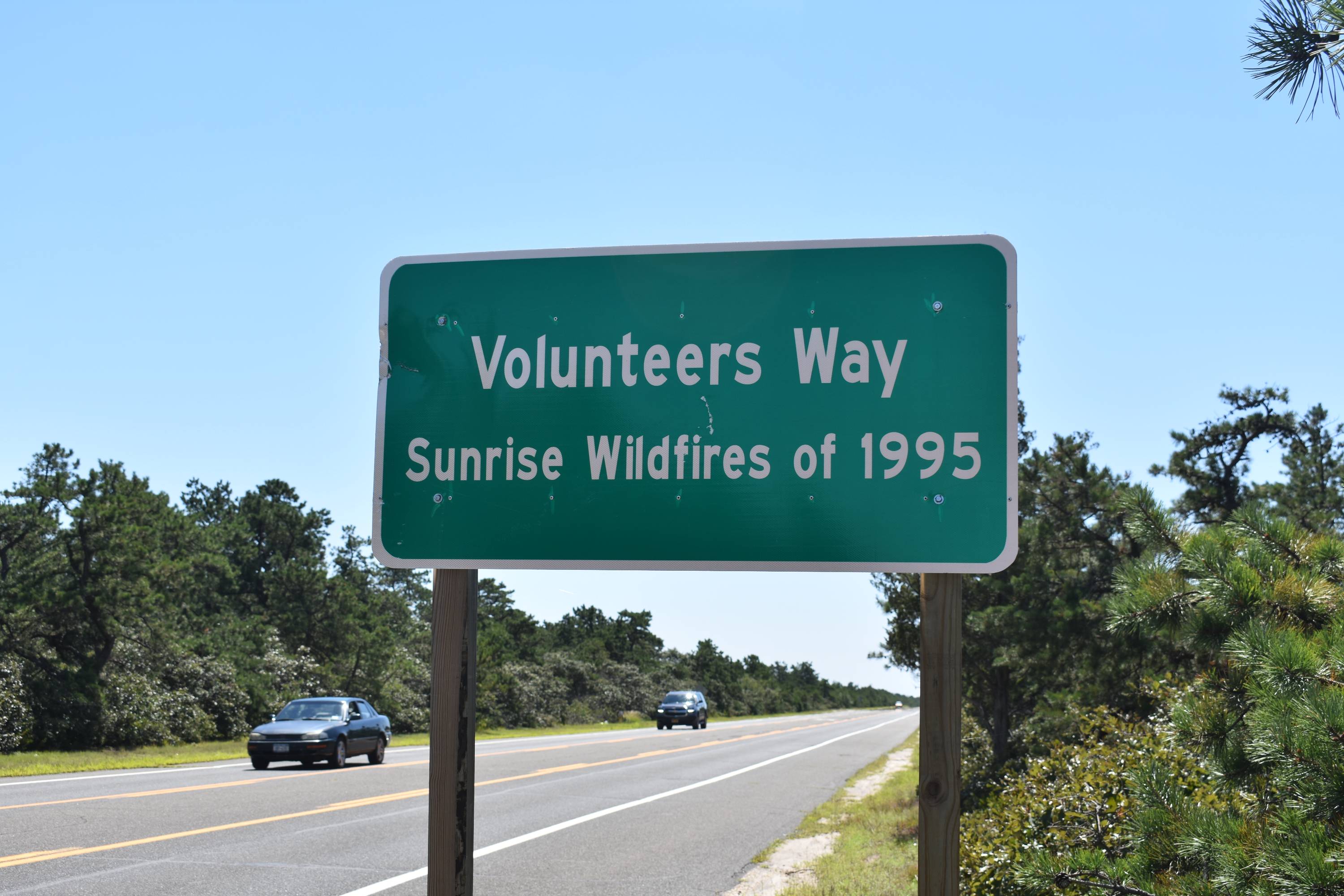
Westhampton Riverhead Road (CR 31) was dedicated to the volunteers who responded in 1995 (Photo: Bob Doda)
Volunteer’s Way – A Different Breed
There was a recurring theme among the volunteer brigade members who spoke with us recently and those interviewed back in 1995 – if one firefighter is in trouble, they were all in trouble together. And they would do anything it takes to make sure everyone returned home safely.
Many firefighters on the scene were still weary from the fires earlier that week at the Rocky Point Natural Resources Management Area that consumed approximately 1,800 acres. It wasn’t placed under control until Aug. 23 – a day before the flames erupted in the Eastport/Northampton area.
But for responders like Frank Fallow Jr. – a retired captain at the Hampton Bays Fire Department now with 48 years of experience as a volunteer – coming to help was “something that came natural.”
“We were all protecting the properties and houses, we had to try to get it out as fast as we could,” says Fallows. “A fire like that puts some life back into you.”
Fallow was the driver of a brush truck, commonly known as “stumpjumpers” – which are designed to drive directly into the forest to fight the flames from within. Forty-five of them were used to fight the Sunrise Fire.
News 12 Vintage: Danielle Campbell reports from the scene
Commissioner Jordan remembers being “glued to the TV” in the North Babylon Fire House. As the situation escalated, he knew the brush fire would become “an invitational.”
“We knew we were going to get called,” he says. “Coming down Sunrise Highway, going from a bright, sunny day…you drove into an atmosphere that was almost midnight. It was pitch black all around you. There was no blue sky over your head. You were in smoke. You were in heat. You were in soot.”
Firefighters reported seeing flames passing 200 feet above them from limb to limb and leaves that burned from the forest floor upward, as if gravity did not apply during this other-worldly happening.
Firefighters are a different breed. We look at a fire. We get excited. Most people look at a fire and they get afraid.
When crews celebrated quelling the flames in one area, they sprung up in another. When volunteers were on the sidelines catching their breath, the orange glow atop the trees brought them back to the fight.
“Firefighters are a different breed. We look at a fire. We get excited. Most people look at a fire and they get afraid,” says Commissioner Jordan. “All the things you are trained for kick in and keep you going for two or three days without leaving or going home.”
ComplicationsOnly a few departments at the scene were seasoned in fighting brush fires – and the massive response was causing communications to break down. In 1995, fire departments had their own radio frequencies and couldn’t communicate with each other.
Today, those responding to mutual aid events can all talk on “U-tac channels” to coordinate emergency responses.
“Incident command exists for a reason – so everybody is operating from the same sheet of music…everybody’s doing it the same,” says Commissioner Jordan.
News 12 Vintage: Communications issues during the response
There was also a late arrival of C-130 airborne tankers supplied by the federal government, capable of dropping up to 5,000 gallons of water in a single shot. According to the New York Times, the 36-hour delay was explained to Gov. George Pataki this way: “The C-130s were not dispatched promptly because the guidance-and-control plane was not available. He said he was grateful for federal aid, but added that the tankers ‘would have been helpful earlier.’”
The Battle Ends
The whipping winds ceased on Saturday, Aug. 26. The efforts of firefighters, the U.S. Forest Service’s “hotshot” crews and pilots dropping water were working. White plumes of smoke mushrooming upward were a welcome sight for the sore, battered and bruised crews operating on little to no rest.
By Sunday, victory had been declared – but the last embers were not stamped out until early September. Forty-nine firefighters were treated for minor injuries. About 10 structures were damaged. There was no loss of life.
Families in neighborhoods surrounding Eastport, Speonk and Westhampton returned home from shelters at Hampton Bays High School and Center Moriches High School. About 200 evacuees had been moved from their previous shelter at Eastport and Westhampton high schools because of shifting winds that covered the locations in smoke.
VIDEO: Stories from the front lines
Aftermath
Communications and training for wildfires have improved since 1995. Firefighters from across the Island come to the training academy in Yaphank where they can ride through the terrain on stumpjumpers and learn the battleground before the next major fire hits.
When the brush fire in the Manorville area erupted in April 2012, a quick response by more than 20 fire departments held the harm to 1,000 acres. It was the most significant wildfire since 1995.
Schneyer says cellphones being a part of everyday life has made reporting fires easier.
“The sooner we know, the sooner we can get there and put fires out,” he said.
Crews are also using safer, larger trucks and bigger water pumps.
VIDEO: Manorville brush fire burns more than 1,000 acres
On September 6, 1995, former Suffolk Rep. Michael Forbes spoke about the Sunrise Fire on the floor of the House of Representatives:
“Mr. Speaker, it has been said that the strongest and finest steel is forged from the hottest fire. So too, the wonderful people of eastern Long Island emerge stronger and more resilient from the worst brush fire in modern memory – bolstered by the bravery of its volunteer firefighters, police and other emergency personnel and by the tens of thousands of acts of kindness displayed throughout this nationally declared disaster that would be televised around the world.”
Forbes, now a deacon in Austin, Texas, was a newly-elected congressman from Quogue in 1995 and saw the flames firsthand. His remembrance of the event was focused on how a community came together.
“It was incredible to witness the thousands of people and hundreds of businesses that for nearly two weeks kept donating food, water, drinks, t-shirts and all manner of items to keep the firefighters fed and as comfortable as possible,” he says.
Suffolk County Executive Robert Gaffney and Gov. Pataki were also at the scene, expressing their solidarity with responders and answering questions from the media.
Pataki remembers craving a vacation with his family in upstate New York after what he says was a “brutal” legislative session. It was cut short quickly when his office called about “a fire in Suffolk County.” Not knowing its severity at the time, he begrudgingly got on a helicopter in Binghamton and headed toward the East End. Then he understood why he had to be there.
“I realized how important this was,” said the former governor. “I saw dozens and dozens of fire engines heading down Sunrise Highway and I knew this is where I had to be.”
It was the first time he had responded to a major disaster while in office.
“My wife and I actually just drove out to the East End yesterday, and every time we come out across Sunrise Highway, we think back to 1995 and those fires. It’s something none of us will ever forget.”
The estimated acreage of damage done by the Sunrise Fire varies across environmental groups and news outlets alike. Hopefully, this story will put the matter to rest. According to Bob Panko – an expert at the Central Pine Barrens Commission – the final tally was 3,198 acres, just short of 5 square miles of scorched earth.
The scars of the Sunrise Fire are all but gone. Thousands of trees were replanted and now flourishing. Amper says the Sunrise Fire did more to put the Pine Barrens on the map than any public education campaign that could be mustered.
“Nobody wants to see a big fire, but it got everyone’s attention,” he said. “Now people treasure these forests and take their children out to see creatures you don’t find in your backyard. It’s a wonderful treasure and something to be shared with the next generation.”
The view from Speonk-Riverhead Road 1995/2020 (Photo: Bob Doda)
REACTIONS
“Whenever crisis strikes, our first responders are ready to respond in force,” said Suffolk County Executive Bellone. “While we have seen the extraordinary work of our first responders during this pandemic, 25 years ago, volunteer firefighters from all across the region came together without hesitation to battle one of the most significant wildfires we have ever seen on the Island. These heroes saved businesses, homes, and most importantly lives.”
Nassau County Executive Laura Curran said in a statement that Nassau County responders have always “heroically and selflessly supported our neighbors in times of crisis.”
The statement continues: “The Sunrise Fire was not only a lesson on limiting the size of a fire, but also on municipal cooperation and educating the public on how to properly care for the land we live on.”
Governor Andrew M. Cuomo said, “The Sunrise Fire was one of Long Island’s largest fires in modern memory and the damage to the communities surrounding the Pine Barrens was reduced significantly by a coordinated effort of firefighting expertise. The bravest responders from across New York and throughout the country helped quickly extinguish the flames to protect the public and homes and businesses in the fire’s path and we will forever be grateful for their courageous work.”
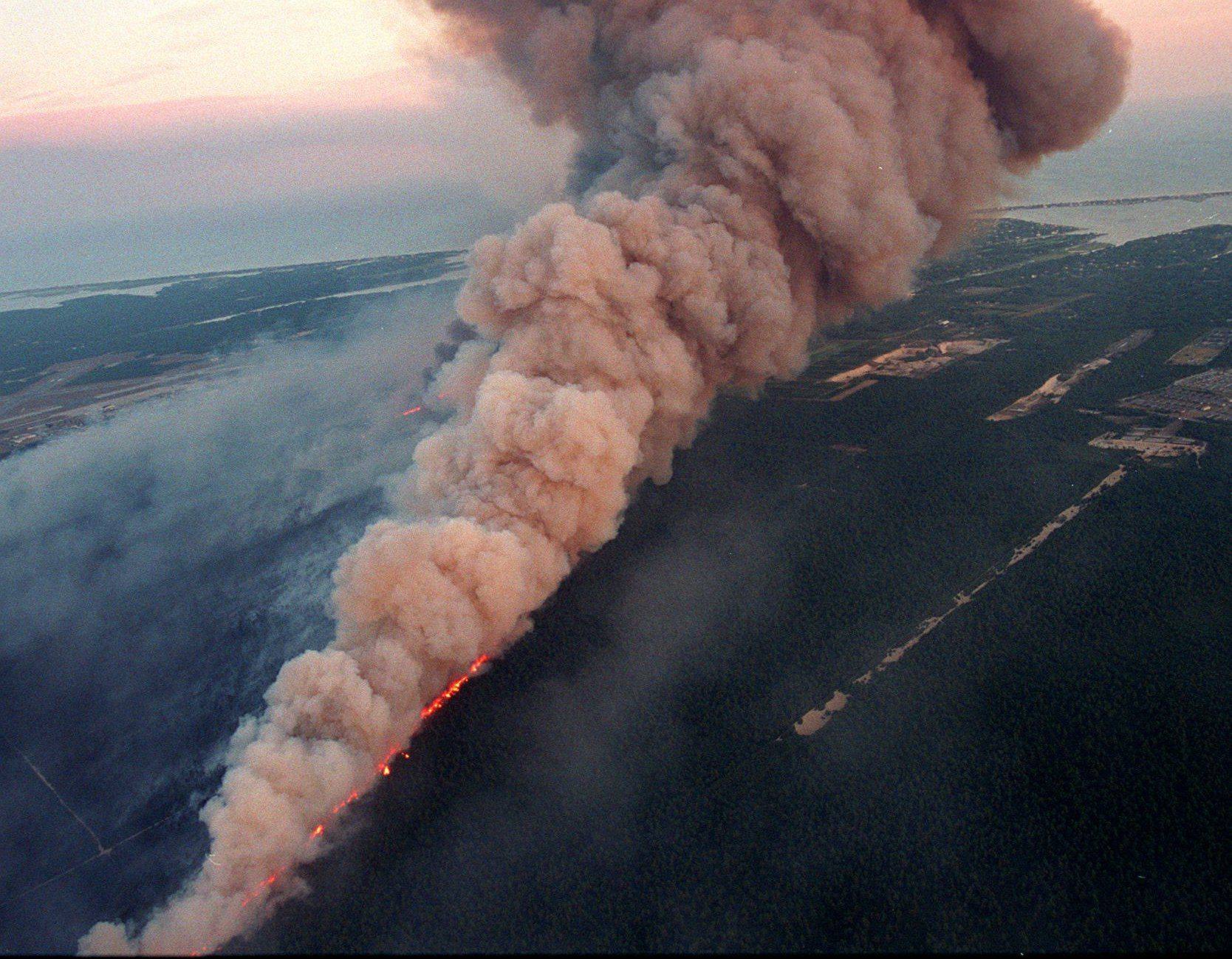
(AP photo)
Project Credits:
Greg Cannella: Producer, Photographer, Editor
Bob Doda: Producer, Writer
Frank Pokorney: Executive Producer
Chris R. Vaccaro: VP of Digital
James DiGregorio: Graphic Design
Timothy Ivers: Archival Video Editor
Photo Credits: News 12, Associated Press, The New York Times, The Express News Group
Special Thanks: Shawn Brown












